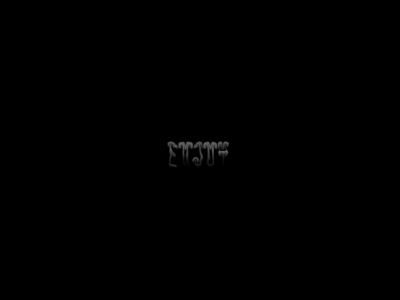First up we'll look at Nesbeth. As you may recall when we last left him he was digging the smooth sounds in his new headphones and trying to nail a key on reflective objects within the scene. As I mentioned before, this didn't turn out to be a problem, because for this particular ad I used the key to artistic effect.
As you can see the final look of Matt in this ad is simply the alpha channel inverted. This is a very simple technique to achieve in Nuke. When using keylight key a green screen, this is the what you will get as an alpha channel. It is simple a matter of using the shuffle node, as handy little node that allows you to "shuffle" the colour channels of any give image around. In this case the alpha was inverted and then shuffled into the RG & B channels respectively, giving this as a final result.
Once the overall visual style was accomplished (and it is based on those Apple iPod adds) it was just a matter of finessing the final product. Again in true apple style I added a particle system which I created with Trapcode Particular and controlled via a few simple expressions written into the Particle emitters transform attributes (where it moves in 3D space) telling it to move around in a random fashion (random(x/2)/5 if you really want to know).
Particle system on its own screened over the existing keyed footage.
The next element to add were the headphones. This was pretty simple as I just made a loose roto shape and essentially cut them out to separate them from the rest of the footage. By doing this I was able to give the particles and the headphones the same colour and again control their changing colour by an expression written into a hueshift node. This time the expression being t*1, of time*1. This makes the hue of the effected element equal the time in the timeline, and thus will change as the time does.
Rotoscoped headphones enabled separation from the rest of the scene.
That was pretty much it for visual elements. This style of advert is very clean and would have been easily over cluttered so I though keeping it simple was the best plan of action. The only other element that was added was the text. This I wanted to keep with the particle theme and also was looking for an excuse to have a play with some Fluid Simulations within Maya. I soon figured out that it was actually pretty easy to take some text with an alpha channel and plug it into the fluids density, making the text the starting point of the fluid.
Once this was rendered from Maya, it was inverted in Nuke to fit the rest of the scene and a Min blend node was used to remove the white and keep the black (opposite to a normal alpha channel).
The final script in Nuke looked a little like this...Exactly like this actually.
This above image represents the node based system that Nuke uses as it's main interface. At the top of the tree there lies the main green screen footage, with the 2 nodes below the keyer and the shuffle node to create the inverted alpha look (B&W). On the right of that is the headphone roto branch with the Hueshift node (shifting colour) and 2 glows to light them up, these 2 paths were then mereged together.
This is the basis of how the Nuke interface works and once you wrap your head around it, it is a lot more streamlined and refined than working in layers.
Anyway, that's enough of that for the moment. Next time I'll be have a look at working with Motion graphics in After Effects.





No comments:
Post a Comment